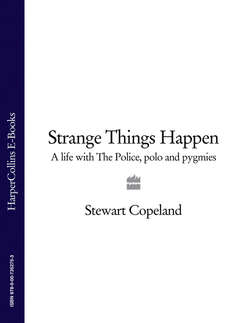Читать книгу Strange Things Happen: A life with The Police, polo and pygmies - Stewart Copeland - Страница 11
2000
YEARS LATER AT PARAMOUNT STUDIO M
ОглавлениеBehind me in the huge control room is the director, his producer, and a couple of studio bosses. In front of me is the seventy-channel mixing console nursed by a five- or six-man recording crew.
Through the glass in front of us we can see the orchestra. There are video monitors everywhere that show us the movie, the recording status, and each other. The score is on my desk in front of me. Jeff Seitz, my man from Juilliard and collaborator of two decades, runs the recording crew while I run the band, and the director behind me runs the executives.
The conductor is on the podium, facing the slickest orchestral talent that money can buy. In his headset he can hear dialogue, metronome click, and me:
“Let’s go to 1m6, measure 25. We’ll drop you in at bar 27. Tacit, please, brass until 32. And you can take them down one dynamic, say…mezzo forte until 36. Everybody play ink at 36. Show me when you’re ready.”
Through the twenty or thirty microphones we can hear the rustling of scores as the sixty players turn to the spot. Pete on the podium conveys the instruction for the horns, trumpets, trombones,
and tuba to not play for the specified six measures and to play slightly less loudly when they do enter. Rustle, Rustle.
He raises his baton. The room stills.
“Roll tape.”
The chatter behind me stops, and the scene is playing on everyone’s screens. At exactly seven minutes, eighteen seconds, and twelve frames into the reel a bright yellow streamer appears on the screen and a loud clicking indicates the tempo of the incoming music. After four clicks the band strikes up—although we can’t yet hear it. We’re listening to music that we recorded on the last pass, as the orchestra plays along in parallel. At measure 27 the recordist hits his red button, and seamlessly we are now hearing the new recording of the current performance.
All this is in response to the client behind me, who wants his favorite line of dialogue to be more clearly audible through the din of sound effects and thrilling music. This is an easy one; all I have to do is carve off some of the orchestra to clear audio space for the dialogue. The mood of the scene is playing well so I don’t have to rewrite the music and put new charts on the stands.
But it does happen sometimes, that a hitherto undisclosed producer will show up at the orchestra date with a brand-new perspective on the scene. This is the last high-octane, thousands-of-dollars-per-minute event of the film production, so distant functionaries whom I’ve never before met will arrive for one last piss on the tree.
“Wait a minute!” such a producer might say. “This scene is supposed to be happy-sad! I’m only hearing sad!”
By the time we get to the hyperexpensive scoring stage the relative happy and sad have been fully calibrated to the satisfaction of the director and more immediate producers. But now this guy wants more happy in this scene. That’s when you have to put the orchestra on a fifteen-minute break, sprint over to the keyboard, and start figuring.
With modern software it’s not too hard to immediately print up new parts to put on the stands. The tricky part is manipulating the emotional message of the chords, melodies, rhythms, and timbres. The film composer has to work very decisively and quickly to hit the precise emotional spot. Composing for full orchestra on the fly separates the men from the boys. I’ve had to learn how to do it with the clock ticking. It’s been the formal part of my music education—and I’ve been paid for all of it!
